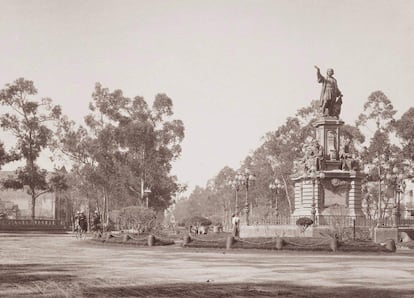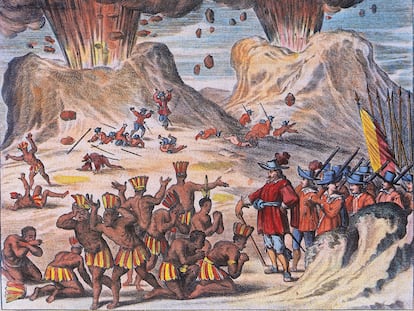Monumental controversies in Mexico
Who deserves the eternality of a statue, and who should be removed from sight? Mexico City’s planned removal of a Christopher Columbus statue and replacement with an indigenous woman’s head has reopened the debate

A new sculpture named ‘Tlali,’ featuring the head of an indigenous woman, is set to replace a monument dedicated to Christopher Columbus in Mexico City’s Paseo de la Reforma. For decades, Columbus occupied a pedestal on the capital’s main avenue, and his removal is only the most recent episode of a controversy that has sparked fevered debate in Mexico and many other countries. The question at hand: what and whom should the public spaces of our cities commemorate? Who deserves to be consecrated in the eternal form of a statue and who should be removed once their reputation fades over time? What do the sculptures that adorn our avenues, roundabouts and parks say about our identity? And do statues serve any purpose, apart from being a landing spot for pigeon droppings and a reference point for cab drivers?
These busts and monuments are not as trivial a matter as they might seem – they appear in every recorded civilization. Gods, heroes, kings and conquerors are popular, but also insubordinates and rebels, or characters considered admirable for their genius or goodness. All have been celebrated in wood, stone or metal over the years. Other statues highlight abstractions or symbols that remind societies of their origins, their aspirations or achievements. We might think of beauty, freedom, patriotism, motherhood, purity, and work – all have been cast in bronze. The paradox comes when the needs of the moment and a striving for permanence collide.
Statues do not simply emerge from the ground and so they can never be neutral, like a tree or a hill. A spot is selected and the statue is paid for, in an attempt to represent the dominant ideas of a certain era. But ordinary citizens do not have the time, money or – generally speaking – the desire to erect them themselves, so they tend to become a symbol of the opinions and interests of governments and nation states, who merely pretend to interpret the will of the citizens.
If we held a public opinion poll, wouldn’t we run the risk of ending up with a giant Baby Yoda, instead of some patriotic figure?
Mexico overflows with busts honoring patriotic heroes and erected by successive governments. Thanks to the brand of nationalism trumpeted by the Institutional Revolutionary Party [which led Mexico from 1929 to 2000], every town and village in the country has one or more statues to Benito Juárez, Miguel Hidalgo, José María Morelos and Lázaro Cárdenas. We might say that these are more or less established characters in the popular imagination and that nobody expects them to be taken down. But there are dozens with a much narrower claim to consensus. General García Barragán, for example, who was Secretary of Defense at the time of the 1968 Tlatelolco massacre and whose likelihood is usually stained with blood red paint.
Those who argue that Mexicans do not feel represented by Columbus today, and who consider him a dubious or nefarious character as the forerunner of the conquest and colonization of the Americas, are probably right. But what would citizens want to put in his place? Tlali’s colossal head, a woman who is supposedly Olmec but who has a Nahuatl name? If we held a public opinion poll, wouldn’t we run the risk of ending up with a giant Baby Yoda, instead of some patriotic figure?
It’s impossible not to think about the story of the Caballito (the little horse), the equestrian statue of King Charles IV of Spain, sculpted by the great Manuel Tolsá. That spent more than a century on the Paseo de la Reforma until it was decided in the 1970s that there was no reason to honor the foreign king of the colonisers. But we Mexicans, geniuses as we are, found a solution worthy of our historical confusions: the Caballito was preserved “out of respect for art,” but in another, less showy location. It was replaced by a reinterpretation of the monument, a new Caballito made of metal, full of curves yet simultaneously angular, and without a mounted king. I don’t know anyone who likes this second Caballito, but at least cab drivers still get to use it as a reference point...
Tu suscripción se está usando en otro dispositivo
¿Quieres añadir otro usuario a tu suscripción?
Si continúas leyendo en este dispositivo, no se podrá leer en el otro.
FlechaTu suscripción se está usando en otro dispositivo y solo puedes acceder a EL PAÍS desde un dispositivo a la vez.
Si quieres compartir tu cuenta, cambia tu suscripción a la modalidad Premium, así podrás añadir otro usuario. Cada uno accederá con su propia cuenta de email, lo que os permitirá personalizar vuestra experiencia en EL PAÍS.
¿Tienes una suscripción de empresa? Accede aquí para contratar más cuentas.
En el caso de no saber quién está usando tu cuenta, te recomendamos cambiar tu contraseña aquí.
Si decides continuar compartiendo tu cuenta, este mensaje se mostrará en tu dispositivo y en el de la otra persona que está usando tu cuenta de forma indefinida, afectando a tu experiencia de lectura. Puedes consultar aquí los términos y condiciones de la suscripción digital.











































